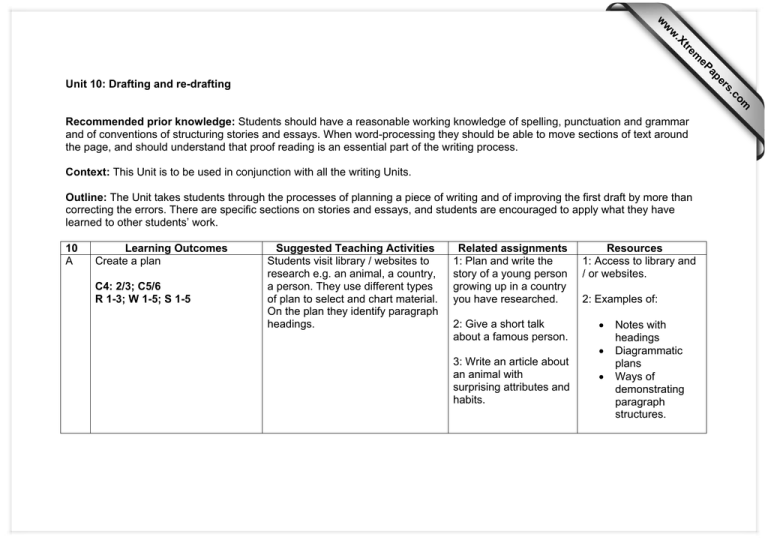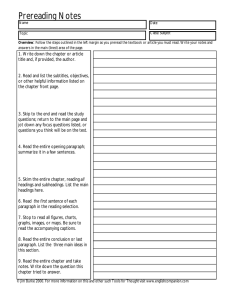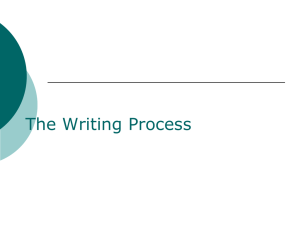Unit 10: Drafting and re-drafting Recommended prior knowledge:
advertisement

s er ap eP m e tr .X w w w Unit 10: Drafting and re-drafting om .c Recommended prior knowledge: Students should have a reasonable working knowledge of spelling, punctuation and grammar and of conventions of structuring stories and essays. When word-processing they should be able to move sections of text around the page, and should understand that proof reading is an essential part of the writing process. Context: This Unit is to be used in conjunction with all the writing Units. Outline: The Unit takes students through the processes of planning a piece of writing and of improving the first draft by more than correcting the errors. There are specific sections on stories and essays, and students are encouraged to apply what they have learned to other students’ work. 10 A Learning Outcomes Create a plan C4: 2/3; C5/6 R 1-3; W 1-5; S 1-5 Suggested Teaching Activities Students visit library / websites to research e.g. an animal, a country, a person. They use different types of plan to select and chart material. On the plan they identify paragraph headings. Related assignments 1: Plan and write the story of a young person growing up in a country you have researched. 2: Give a short talk about a famous person. Resources 1: Access to library and / or websites. 2: Examples of: • • 3: Write an article about an animal with surprising attributes and habits. • Notes with headings Diagrammatic plans Ways of demonstrating paragraph structures. 10 B Learning Outcomes Edit and revise a first draft R3-4; W 2-5; S1 C Read proofs and correct them D Improve beginnings, climaxes and ends C6 R 3-4; W 1-3; S 1-5 Suggested Teaching Activities 1: Discuss and teach how to revise a document: • Parts too long / short • Ending / beginning ineffective • Order poor. Related assignments 1: Provide an edited / revised draft and write a side to explain what has been done. Resources 1: Students’ first draft and edited / revised drafts. 2: Write a handwritten draft on a left hand page. Make alterations neatly and clearly and write new version on the right hand page. 2: Discuss and teach how to edit: • Choice of words weak / too ambitious • Sentences unvaried / too short / too long and shapeless • Too many words. Teach strategies for proof reading /self-correction. Warn of typing errors. Give practice using other students’ first drafts, and own work. Revise spelling, punctuation and grammar. Study a short story /stories to discuss how writers achieve effects when beginning and ending a story, and how they build up to climaxes by creating atmosphere and tension and by manipulating events. 1: Class read photocopies of first drafts and correct them silently. They discuss what they have found. 1: Class copies of letters and articles with first draft errors. 1: Discuss how writers use beginnings to engage their readers’ attention and to provide information. 1: Two or three short stories and some extra beginnings. Practise writing beginnings to short stories. 2: Identify climaxes and relate them to what happens in the story before and after. 10 E Learning Outcomes Order and develop ideas and arguments C3: Sect.2; C4: 1; C6 W2, W5 (and other writing objectives) S 1-5 F Assess someone else’s work C6 R 1-5 S 1-5 Suggested Teaching Activities Set a standard essay topic, such as the importance of sport in the curriculum. In groups, discuss possible paragraph headings. Teacher chooses five and gives them to groups to discuss the best way of ordering them. Groups discuss how to develop each paragraph in a convincing sequence. At the end of this process, read a published article on the same topic and analyse the presentation of the writer’s argument. Students read (a) a first draft and (b) a final draft of someone else’s writing and comment on its quality. Alternatives are: • The work of someone in the class • A younger student’s writing • A newspaper report (for structure). Related assignments 1: Write the essay as discussed in groups. Resources 1: A well-argued article on the topic(s) on which the class is working. 2: Plan a five-paragraph essay and write a justification for the order of the paragraphs. 3: Write two of the paragraphs in full, taking care of the sequence of ideas, each paragraph to be approximately half a side. Checklist for comments: • What you would revise • What you would edit • Corrections and proof-reading • Structure and sequencing • Effectiveness of beginnings and endings. 1: Each other’s writing or examples of writing from other classes. 2: Examples of poorly structured or developed newspaper reports.






